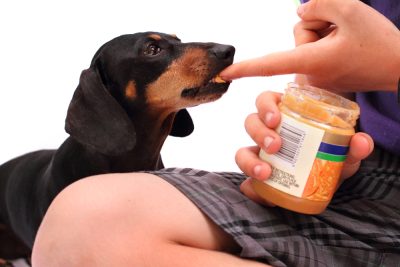FAQs About Xylitol Toxicity in Dogs

Xylitol is a substance found in numerous foods and human products because the ingredient has many beneficial effects for people. However, xylitol is toxic to dogs if ingested, and can result in devastating consequences.
Our team wants to help you care for your pet like a hero, and we answer frequently asked questions about xylitol toxicity in dogs.
Question: What is xylitol?
A: Xylitol, also called birch sugar, is a natural sugar alcohol that is a carbohydrate type found in many fruit and vegetable fibers. Sugar alcohols have traits of sugar and alcohol molecules, and their structure allows them to stimulate taste receptors on the tongue for sweetness.
Q: What products contain xylitol?
A: Xylitol is found in numerous human products, including:
- Candies, gum, and mints
- Peanut and other nut butters
- Sweet treats, such as cookies, desserts, ice cream, and yogurt
- Jams and syrups
- Condiments and sauces
- Honey and other sweeteners
- Power and protein bars
- Toothpaste, dental floss, and mouthwash
- Medications, vitamins, and supplements
- Cosmetics, hair care, and face and body lotions
Q: Why is xylitol used in so many human products?
A: Xylitol is a popular ingredient in human products because of the substance's many beneficial effects for people, including:
- Better than sugar- Xylitol is similar in sweetness to regular sugar, but contains 40% fewer calories per gram.
- Low glycemic index- Xylitol doesn't contain fructose and has negligible effects on blood sugar and insulin. Xylitol's glycemic index, which measures how quickly a food raises blood sugar, is 7 compared to sugar's 60 to 70. This makes xylitol a great sugar alternative for people looking to lose weight, who are diabetic or prediabetic, or have other metabolic conditions.
- Promote dental health- Studies show that xylitol improves dental health and helps prevent tooth decay in humans.Streptococcus mutans,which are the bacteria most responsible for plaque, survive by feeding on glucose, but cannot use xylitol. After absorbing xylitol, they cannot ingest glucose, so they die.
Q: Why is xylitol toxic to dogs?
A: Our canine friends digest xylitol differently. Humans slowly absorb xylitol from the small intestine and the liver mostly metabolizes the substance. In dogs, xylitol has two potentially deadly effects:
- Hypoglycemia- The dog's pancreas confuses xylitol with real sugar, releases a dose-dependent amount of insulin, and blood sugar levels plummet. Signs include vomiting, weakness, incoordination, tremors, and seizures. Signs typically start about 30 minutes after ingestion, but may take up to 12 hours to manifest.
- Liver failure- The exact cause is unknown, but high xylitol doses can lead to liver failure, typically involving clotting abnormalities and internal hemorrhage.
Q: How much xylitol is dangerous for dogs?
A: Xylitol's hypoglycemic toxic dose for dogs is about 0.1 milligrams per kilogram (mg/kg). At doses higher than 0.5 mg/kg, liver toxicity can occur. Xylitol concentrations can be extremely variable in different products, but one stick of gum or candy piece can easily poison a small dog, depending on the product.
Q: Is xylitol toxic to cats?
A: Current studies suggest that cats are not affected by xylitol toxicity, but we advise against giving your cat xylitol-containing products.
Q: What should I do if my dog ingests xylitol?
A: If your dog ingests a xylitol-containing product, follow these steps:
- Stay calm- Remain calm, so you can provide the care your dog needs.
- Remove the product- Take the product from your dog so they can't ingest more xylitol.
- Make a call- Call our Gentle Touch Animal Hospital team or Animal Poison Control for expert advice on caring for your dog.
- Preserve the label- Keep the label, so you can relay product information, such as the name and the amount of xylitol in a serving.
- Answer questions- Be able to answer questions, such as:
- How old is your dog?
- How much does your dog weigh?
- What breed is your dog?
- How much product did your dog eat?
- When did they eat the product?
- Are they exhibiting signs?
- How much xylitol is in the product?
- Be observant- If your dog vomits, note the contents and amount.
- Seek veterinary care- Seek veterinary care as soon as possible.
Q: How is xylitol toxicity treated in dogs?
A: In cases where the dog is alert and acting normally, our veterinary team may induce vomiting-which should be done only under a veterinarian's supervision. We don't typically use activated charcoal, which doesn't sufficiently bind xylitol. Other potential treatments include:
- For hypoglycemic toxic doses- Dogs who ingest more than 0.1 mg/kg are placed on intravenous fluids, and closely monitored for hypoglycemia. Dextrose supplementation may be necessary if blood sugar levels are low.
- For liver toxic doses- Dogs who ingest more than 0.5 mg/kg are treated with dextrose supplementation and liver protective medications, and closely monitored for hypoglycemia and liver damage.
The prognosis for xylitol toxicity is good for dogs who are treated early and don't develop complications.
Q: How is xylitol toxicity prevented in dogs?
A: You can decrease your dog's xylitol toxicity risk by:
- Reading the label- Read the label on any product you offer your dog to ensure xylitol is not an ingredient.
- Storing food appropriately- Keep all food behind latched cabinets or in air-tight, sealed containers.
- Securing personal belongings- Many people carry gum or mints in their handbags. Ensure your dog cannot access your guests' personal belongings.
- Use dog-friendly dental products- When brushing your dog's teeth, use only dog-specific dental products.
If your dog ingests xylitol, contact our American Animal Hospital Association (AAHA)-accredited team at Gentle Touch Animal Hospital, so we can formulate an appropriate treatment strategy.





